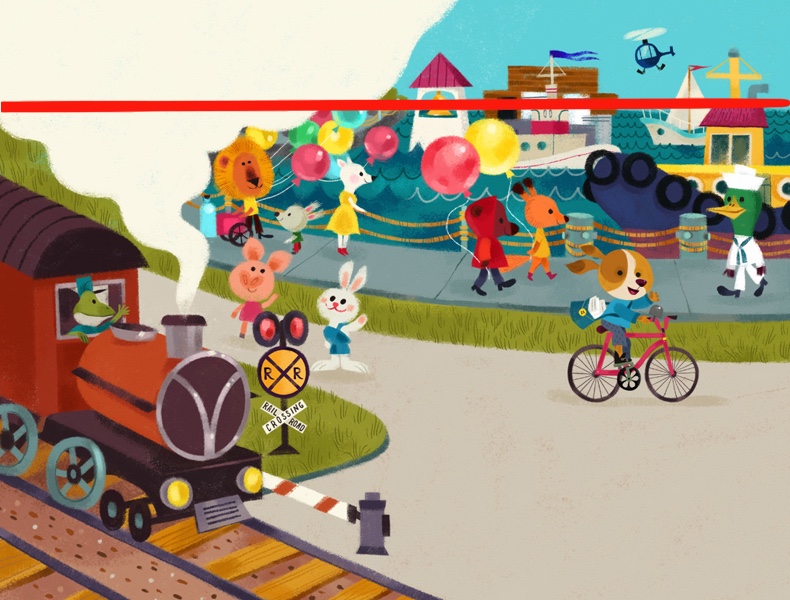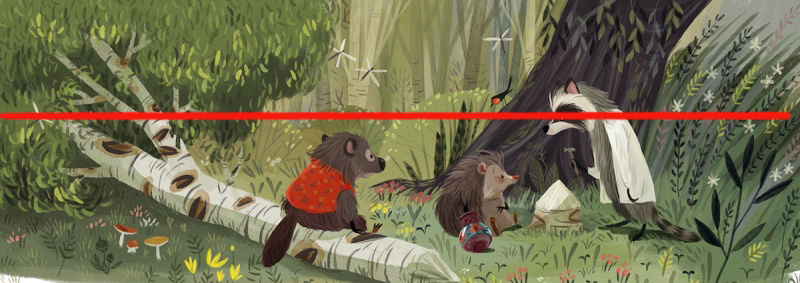Perspective without buildings (characters only)
-
@tessaw thanks for this reference—I was not familiar with her delightful work.
So before I try to see if I can recognize all the ways she achieves depth in these, let’s see if I understand how to identify the more basic concept of horizon.In the first image, I apply the rule it’s where the sky meets the ground (sea).

In the second image, I am just guessing because I can’t clearly see where the sky meets the ground. So, it looks like the raccoon’s eye is at eye level, and if I try to visualize the badger and hedgehog as cylinders, I can see the tops of the cylinders, so they are below eye level.

If I didn’t get the horizons right, can you tell me where they are and your thought process to properly identify the horizons? Thanks for all your help!
-
@bichonbistro I'm sure @TessaW will stop in to reply as well, but since I'm here and reading this thread I'll offer my two cents right now -- YEP! That's how I would go about determining the horizon lines for these two images. I'd put the HL in exactly that spot for the ocean image, while I think the HL you chose works just fine for the woods. Although I think you could also make a decent argument to move the HL slightly higher for that image. That particular image utilizes "overlap" and "atmospheric perspective" (value) rather than linear perspective to create the illusion of space.
-
@BichonBistro
It's good to ask questions--we are here to learn! Reading the threads that others post--including yours--is helping me understand things better, too. -
@davidhohn I had to look up “orthogonals”
 , but pleased to read that I am on the right track and reassuring that you had to do this kind of work EVERY time when you were learning perspective.
, but pleased to read that I am on the right track and reassuring that you had to do this kind of work EVERY time when you were learning perspective.I have felt so dense about trying to grasp these concepts that I am taking a Coursera class called “Learning how to learn” because it feels so much like math to me and that course was created by a woman who hated math. I told my husband last night that I don’t understand why I am like a dog with a bone when it comes to problem-solving in EVERY area except art—I will not let go until it’s resolved. But in art, my tendency has always been to give up. So, I made a commitment almost a year ago that I will NOT give up this time, even if it takes me the rest of my life to get it. Thanks for the encouragement!
-
@miriam Thanks!
-
Patty, I understand your struggle very well! I started studying perspective in Jan 2014. I've had many breaks from art since then, but I think it took until mid 2017 to feel comfortable with it, and I'm still learning about it!
When I first started studying perspective, I studied it intensely for a month. For a long time after that, I still constantly got it so so wrong, it was still so confusing to apply it to my work, and it took a very long time to plot things out. I wasn't producing a lot of work that involved perspective, so maybe if I did I would have grasped it sooner. It took more rounds of study, analyzing photographs, movie stills, and other artwork, applying it to my own pieces, and studying composition in books and classes to get semi comfortable with it. This was all spread out through years. I still have to figure things out, but I've gotten to the point where I know I can work through perspective problems and it's not super tedious anymore. (Usually, lol). If you keep applying it to your work, go back and do drills from time to time, try to recognize perspective in other artist's artwork, you will get there, probably faster than I did if you don't take extended breaks from art like me.
-
@tessaw it’s reassuring to hear you have struggled too, because you have clearly reached an enviable level of understanding! One of the interesting concepts in that “Learning how to learn” course is that sometimes it is best to move onto the next chapter even if you don’t yet have a solid understanding of what you think of as pre-requisite. “Spaced repetition” (deliberate breaks)instead of repeatedly beating your head against the wall to understand a concept has been demonstrated to be a more effective learning strategy according to the research quoted. So when I looked at the SVS course curriculum levels, I thought “boy did I get my sequence wrong”, but now I am thinking of it as a useful “looking ahead” that will help clarify & cement concepts that I am trying to learn as I go back to the basics in level 1. I am now more flexible about jumping back and forth between courses, as it sounds like that may actually enhance learning. Another recommended strategy is to consciously think of the most important points (in my case, from an SVS video chapter) right before you go to sleep.
-
@miriam for anybody who has struggled with BASICS of perspective like I have, this is a cool video that highlights the most important points in less than a minute. With my math phobia, I found the parallel (learned a new word from @davidhohn, orthogonal
 ) line designations here more palatable than “X, Y,Z” (yikes, algebra
) line designations here more palatable than “X, Y,Z” (yikes, algebra

https://m.youtube.com/watch?feature=youtu.be&v=ROlHybuf7cs -
That's awesome that you're taking that course, I'll have to look into it. I very much believe in deliberate breaks too. I've found that I will usually notice a jump in improvement when I go back to studying a topic after a nice long break from it.
-
@bichonbistro Be assured that even though you are the one brave enough to ask the questions, there are plenty of us who are going to benefit from the answers! I for one am pretty clueless about this stuff!!